|
Lagerstätten (singular Lagerstätte) are fossil-bearing sites with extraordinary diversity and completeness or quality of preservation. They provide a detailed look into specific prehistoric environments. In lab we have a number of fossils representing various important Lagerstätte from around the world. They are presented below from oldest to youngest. Ma = Mega-annum or million years (ago).
Chengjiang Fauna (Maotianshan Shales)
Location: China
Age: Early Cambrian Period, about 518 Ma
Description: A marine site that is a bit older than the Burgess Shale, also with excellent (but different) preservation. It has revealed hundreds of species, including those of obscure groups with soft bodies such as various types of worms.
|
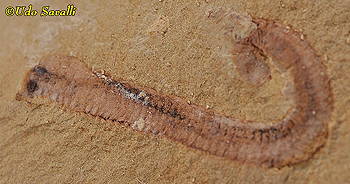
|
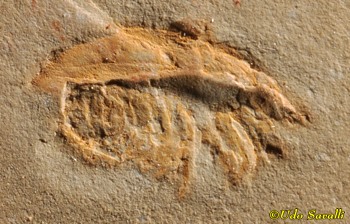
|
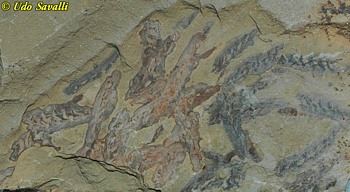
|
|
The soft-bodied marine worm Palaeoscolex sp. has only a few surviving relatives today.
|
Leanchoilia is a primitive arthropod (relative of spiders, crabs, insects and trilobites)
|
A group of Haikouella lanceolata, a small, simple jawless fish and one of the earliest known vertebrates (at Wyoming Dinosaur Center)
|
House Range
Location: Western Utah
Age: Middle Cambrian Period, about 505 Ma
Description: A marine site that has a similar fauna to the famous Burgess Shale (though with less detailed preservation). Famous for its abundance of trilobites
|
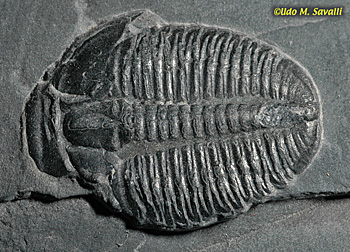
|
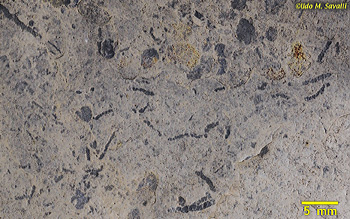
|
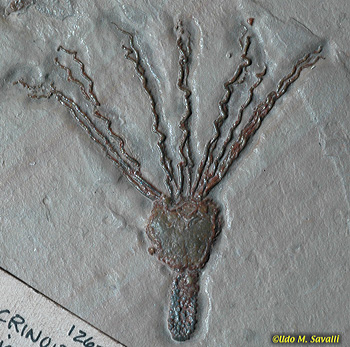
|
|
The trilobite Elrathia kingi is the most abundant and famous of the fossils in this area.
|
Some soft-bodied organisms, such as these disk-shaped cyanobacteria colonies (Morania fragmenta) and filamentous algae (Yuknessia simplex), are preserved as carbon films.
|
The eocrinoid Gogia spiralis is a distant ancestor of sea lilies and sea stars (at Museum of Ancient Life, UT)
|
Hunsrück Slate (Bundenbach)
Location: Germany
Age: Early Devonian Period, about 408-400 Ma
Description: Marine deposits in which organisms have become pyritized (mineralized with pyrite), preserving even soft tissue. Well known for its preservation of echinoderms and trilobites.
|
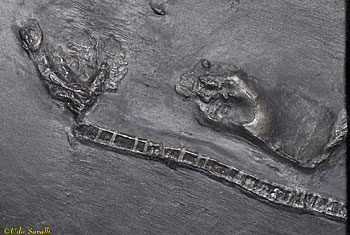
|
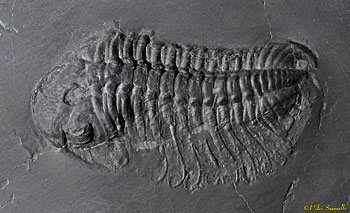
|
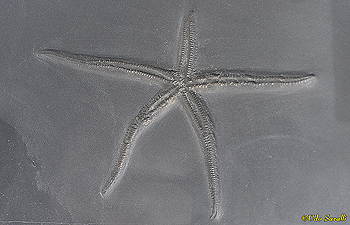
|
|
A crinoid (sea lily), possibly Hapalocrinus sp., and Conularia sp., (a conulariid, extinct relatives of jellyfish; right side).
|
The trilobite Chotecops ferdinandi: note the delicate fin lobes along one side.
|
Fossil of the sea star Hystrigaster horridus (at Black Hills Institute Museum, SD)
|
Bear Gulch Limestone
Location: Montana
Age: Carboniferous Period, about 318 Ma
Description: A shallow water coastal site famous for well preserved soft-bodied fish such as primitive sharks (which lack bone)
|
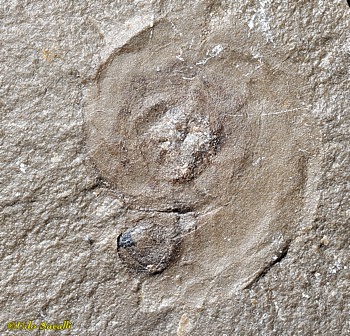
|
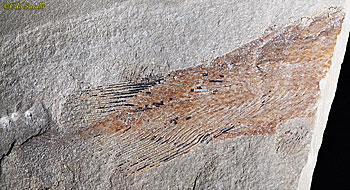
|
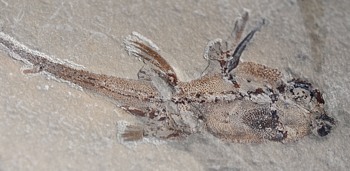
|
|
Goniatites (Anthracoceras sp.) are shelled cephalopod mollusks related to squid and octopi; note mass presumed to be soft tissue of the body near the shell opening (bottom)
|
The tail end of the coelacanth fish, Caridosuctor populosum
|
Echinochimera melton is a distant ancestor of of deep-sea ratfishes (shark relatives) (at Museum of the Rockies, MT)
|
Mazon Creek
Location: Illinois
Age: Carboniferous Period, about 300 Ma
Description: This area was a heavily vegetated tropical swamp. Fossils occur primarily in ironstone concretions that are split to reveal delicate impressions.
|
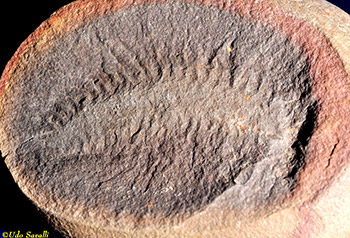
|
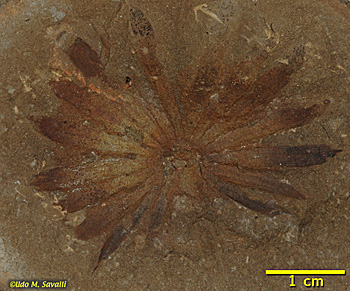
|
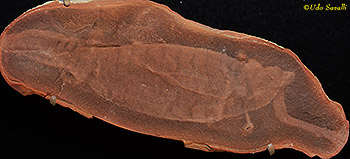
|
|
A bristle worm (Fossundecima konecniorum )
|
Annularia sp., a relative of modern horsetails
|
The "Tully Monster," Tullimonstrum gregarium, a possible early lamprey fish (Field Museum, Chicago)
|
Chinle Group
Location: Mostly Arizona and New Mexico (with some exposures in NV, UT, CO, possibly to TX)
Age: Late Triassic Period, about 222-212 Ma
Description: A complex series of layers that were formerly treated as a single Chinle Formation, but now often subdivided into separate formations. This is a "concentration" lagerstätte known for its large number of fossils rather than their preservation. It is famous for its petrified wood as well as numerous fossils of early dinosaurs and pseudosuchians.
|
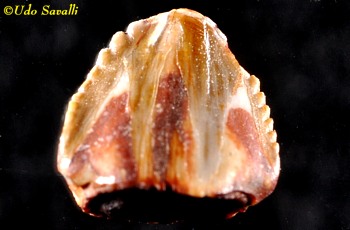
|
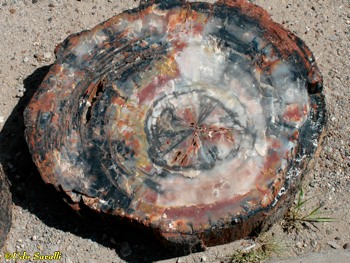
|
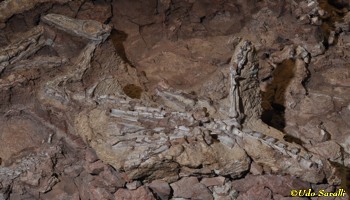
|
|
A tooth from Revueltosaurus sp., a pseudosuchian related to aetosaurs
|
Araucarioxylon arizonicum petrified wood, in the field (Petrified Forest Natural Park)
|
A Coelophysis sp. dinosaur skeleton in a block with multiple individuals (New Mexico Museum of Natural History)
|
Holzmaden/Posidonia Shale
Location: Germany
Age: Early Jurassic Period, about 180 Ma
Description: Oil shales from a marine environment with detailed preservation of ammonites, crinoids, and marine reptiles.
|
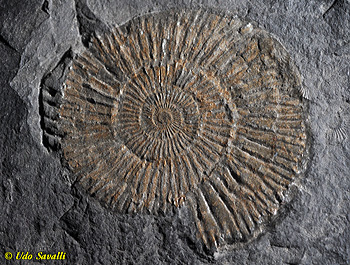
|
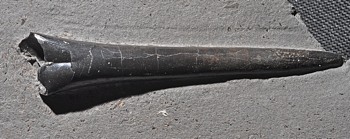
|
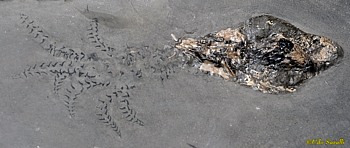
|
|
Dactylioceras ammonite shell
|
The internal shell of Youngibelus, a squid-like animal
|
Phragmoteuthis concaudia, a soft-bodied squid with hooks along its tentacles (at the Black Hills Institute)
|
Morrison Formation
Location: Western United States
Age: Late Jurassic Period, about 150 Ma
Description: A "concentration" lagerstätte, meaning it is important for its large numbers of fossils rather than the quality of preservation. Contains large numbers of mineralized dinosaur bones from a large diversity of species.
|

|
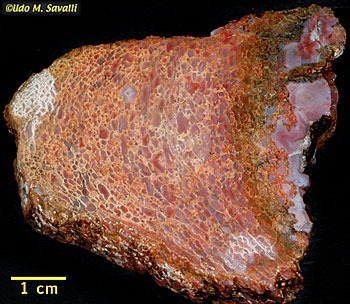
|
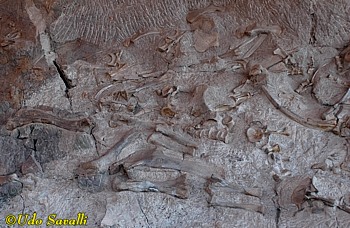
|
|
Radius (forearm) bone probably from Camptosaurus
|
Cut and polished dinosaur bone, showing internal structure
|
Dinosaur bones, mostly from Apatosaurus, still in rock at Dinosaur National Monument
|
Solnhofen Limestone
Location: Germany
Age: Late Jurassic Period, about 145 Ma
Description: This site was a shallow salt-water lagoon that also trapped some animals from surrounding uplands. Most famous for the detailed preservation of pterosaurs and Archaeopteryx fossils.
|
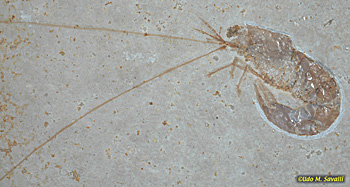
|
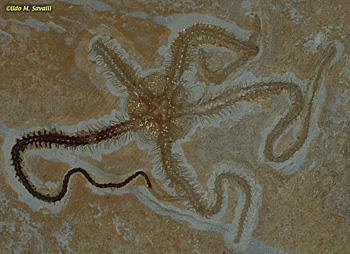
|
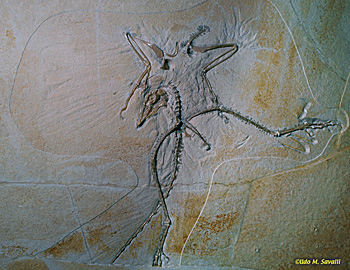
|
|
An unidentified shrimp
|
A brittlestar, Ophiopetra sp.
|
Archaeopteryx, the oldest known bird (actual fossil photographed at the Wyoming Dinosaur Center)
|
Yixian Formation/Jehol Biota
Location: Liaoning Province, China
Age: Early Cretaceous Period, about 125 Ma
Description: Excellent preservation, including impressions of soft parts. Most famous for its preservation of early birds and small feathered dinosaurs.
|
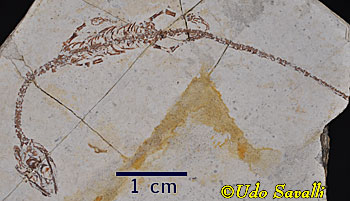
|
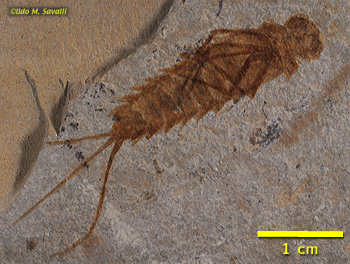
|
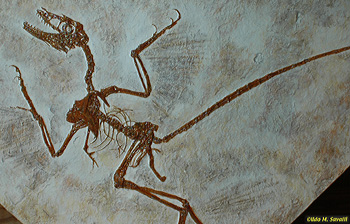
|
|
A juvenile Hyphalosaurus lingyuanensis, a semiaquatic reptile
|
A larval mayfly, Ephemeropsis sp.
|
Microraptor zhaoianus, a small, feathered dinosaur (at Wyoming Dinosaur Center)
|
Santana Group (Romualdo & Crato Formations)
Location: Brazil
Age: Late Cretaceous Period, about 115-108 Ma
Description: A shallow inland sea that preserved fishes as well as plants, insects, pterosaurs, and other animals from the surrounding lands. Some fossils are encased in limestone nodules that preserve even soft anatomy and 3-D shape. Formerly considered a single formation (the Santana Formation), better knowledge of the geology has led to it being split into several formations combined into a single group (as was also done with the Chinle Group, above).
|
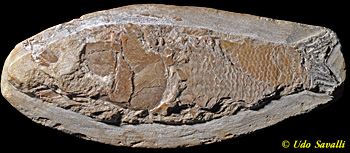
|

|
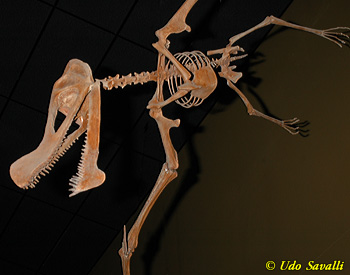
|
|
A fish, Rhacolepis sp., preserved in 3D relief in a limestone nodule
|
A cockroach from the slightly older Crato Formation
|
Santanadactylus, a pterosaur (at the Wyoming Dinosaur Center)
|
Sannine Formation, Lebanon
Location: Sahel Alma, Hajoula & Haqel, Lebanon
Age: Late Cretaceous Period, about 95 Ma
Description: Several sites that contain abundant marine animals, especially fishes, often with soft-body preservation.
|
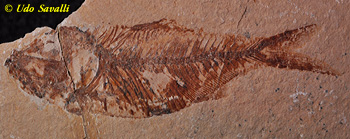
|
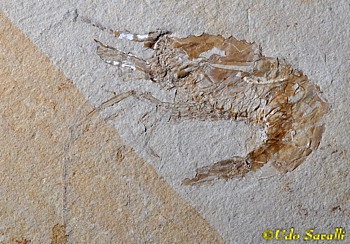
|
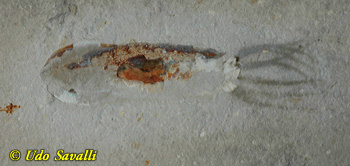
|
|
A fish, Armigatus sp.
|
A shrimp, Carpopenaeus sp.
|
Squid, such as this Acaethoteuthis sp.. are soft-bodied and rarely fossilized (at Museum of Ancient Life)
|
Hell Creek Formation
Location: Primarily eastern Montana & western North Dakota
Age: Late Cretaceous Period, about 66 Ma
Description: Large concentrations of dinosaur bones and other vertebrate fossils, with some limited soft-part preservation (skin impressions, cartilage), also numerous microfossils. Covers the period up to the extinction of the dinosaurs.
|
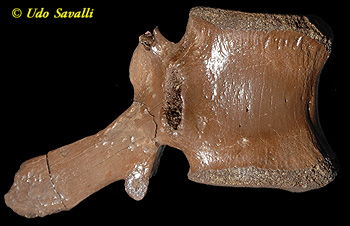
|
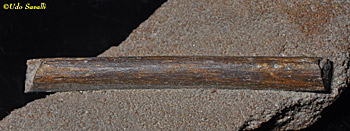
|
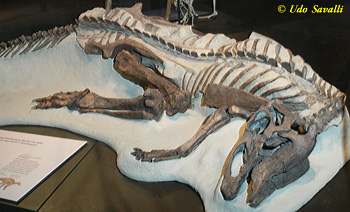
|
|
A vertebra from the dinosaur Thescelosaurus
|
Ossified (hardened into bone) tendon of a hadrosaur dinosaur
|
An articulated fossil of the dinosaur Edmontosaurus.
|
Green River Formation
Location: Southwest Wyoming and nearby areas of adjacent states
Age: Eocene Epoch, about 50 Ma
Description: Formed from the sediments of several large lakes in a subtropical climate. Most famous for its abundance of fish fossils, but a wide variety of plants, insects, and other vertebrates are also preserved.
|
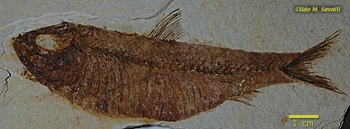
|
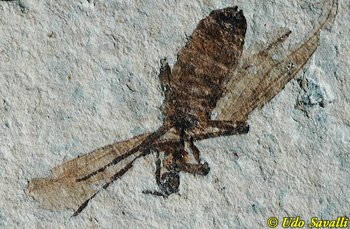
|
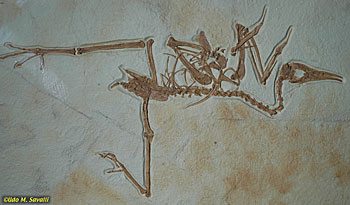
|
|
A fresh-water fish, Knightia eocena
|
A march fly, Plecia pealei fossil
|
A primitive bird, Pseudocrypturus cercanaxius (at Fossil Butte Nat. Monument)
|
Messel Pit
Location: Germany
Age: Eocene Epoch, about 47 Ma
Description: A former oil shale mine that contains numerous fossils of animals accumulated in a deep lake with low O2 levels and occassional outgassings of toxic volcanic gasses (Low O2 inhibits decomposition, while toxic gasses resulted in sudden deaths, in some cases while still mating!) The water-logged shales quickly dry and crumble when exposed to air, so to preserve the fossils they must be immediately transferred to and stored in liquid. They are then prepared by applying a special varnish to the fossils that can be absorbed by the fossils but not the matrix. One side is exposed, the matrix removed, and then covered in a resin (usually stained to resemble the original matrix), then it is flipped and the other side (that you see) is exposed. Thus, the fossil bones and organic tissue are real but the shale matrix has been replaced. Messel is known for preserved mammals (including early primates and bats), reptiles, birds, and fish.
|
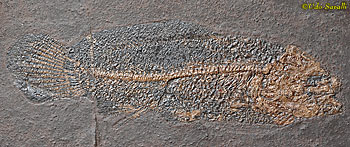
|
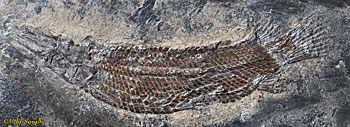
|
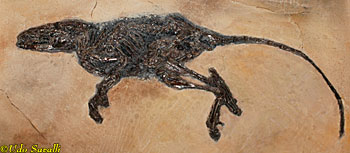
|
|
A bowfin fish, Cyclurus kehreri. As with all Messel fossils, the fish is real, but the matrix is replaced with resin.
|
A gar fish, Atractosteus strausi (at Black Hills Institute, SD)
|
A fossil hedgehog ancestor, Macrocranion tupaiodon (at San Diego Nat. History Museum)
|
White River Formation
Location: Nebraska, South Dakota and nearby areas
Age: Eocene Epoch, 37-30 Ma
Description: A concentration lagerstätte with large numbers of mammal fossils, including many articulated skeletons.
|
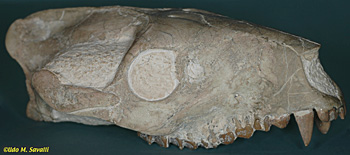
|
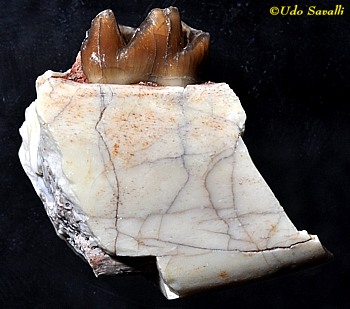
|
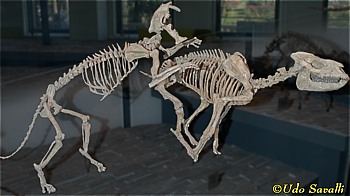
|
|
The skull of an oreodont (sheep-sized grazing mammal), Miniochoerus gracilis
|
Part of jaw and tooth of the ancient horse, Mesohippus sp.
|
Skeletons of Holophoneus (prehistoric cat) and Hyracodon (prehistoric rhino) (at LA Museum of Nat. Hist.)
|
Florissant Formation
Location: Central Colorado
Age: Eocene Epoch, about 34 Ma
Description: Formed from volcanic ash that settled in a lake formed by a blocked river. Volcanic mud flows also burried tree stumps. Preserves mostly plants and insects (along with a few vertebrates) in great detail.
|
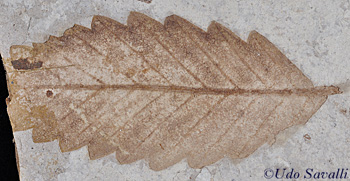
|
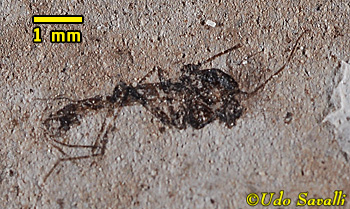
|
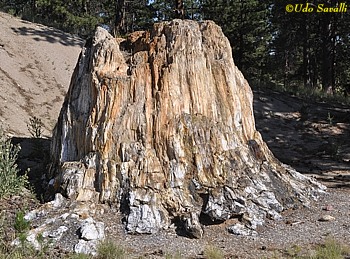
|
|
A leaf from an extinct beech tree, Fagopsis longifolia
|
A non-biting midge, Chironomus sp.
|
Petrified redwood tree stump, Sequoioxcylon pearsalli (at Florissant Fossil Beds Nat. Monument)
|
Rancho La Brea Tar Pits
Location: Los Angeles, California
Age: Pleistocene Epoch, between 50,000 and 11,000 years ago
Description: Naturally occurring pits of oil and tar trapped a diverse array of animals coming in to drink (and still do so today). The well-preserved but dark-stained bones provide a detailed look at life in California. Many of the same animals would have lived in Arizona.
|

|
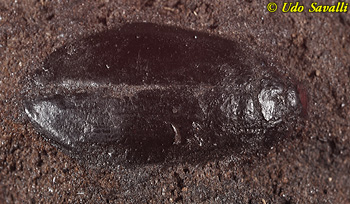
|
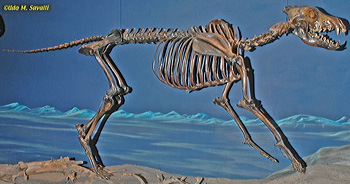
|
|
The humerus from an unidentified bird of prey.
|
A water beetle, Hydrophilus sp.
|
The Dire Wolf, Aenocyon dirus is one of the most common fossils at the Tar Pits (at Page Museum, LA, CA)
|
Amber Sites
Description: Amber is a fossilized tree resin (chemical fossil) and has been found in many parts of the world. Several sites, of different ages, are especially important for frequently preserving "inclusions"—trapped small animals (insects, spiders) and plant material—in perfect detail. The three most important sites are described here.
Burmese Amber: From Burma (Myanmar); dates to the late Cretaceous Period, 99 Ma. Has even preserved juvenile birds and parts of small dinosaurs.
Baltic Amber: From NE Europe and Russia around Baltic Sea; dates to the Eocene Epoch, about 44 Ma (though dating is controversial). Very abundant amber.
Dominican Amber: From the Dominican Republic; dates to the late Oligocene Epoch, roughly 25 Ma. Inclusions are especially common in this amber.
|
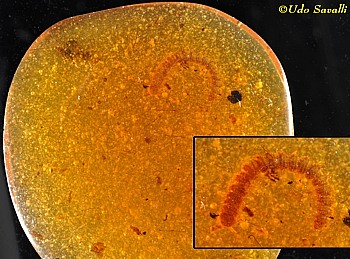
|
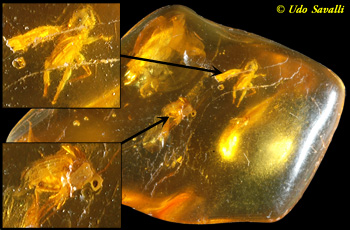
|
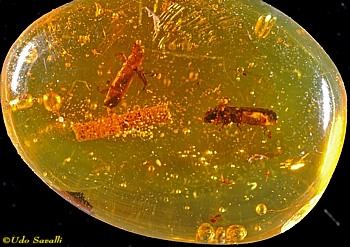
|
|
Burmese Amber with a polydesmid millipede
|
Baltic Amber with 3 unidentified flies and an aphid
|
Dominican Amber with 2 pin-hole borer beetles
|
|
























































